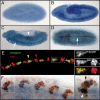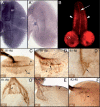The guanine exchange factor vav controls axon growth and guidance during Drosophila development
- PMID: 20147552
- PMCID: PMC6634040
- DOI: 10.1523/JNEUROSCI.1820-09.2010
The guanine exchange factor vav controls axon growth and guidance during Drosophila development
Abstract
The Vav proteins are guanine exchange factors (GEFs) that trigger the activation of the Rho GTPases in general and the Rac family in particular. While the role of the mammalian vav genes has been extensively studied in the hematopoietic system and the immune response, there is little information regarding the role of vav outside of these systems. Here, we report that the single Drosophila vav homolog is ubiquitously expressed during development, although it is enriched along the embryonic ventral midline and in the larval eye discs and brain. We have analyzed the role that vav plays during development by generating Drosophila null mutant alleles. Our results indicate that vav is required during embryogenesis to prevent longitudinal axons from crossing the midline. Later on, during larval development, vav is required within the axons to regulate photoreceptor axon targeting to the optic lobe. Finally, we demonstrate that adult vav mutant escapers, which exhibit coordination problems, display axon growth defects in the ellipsoid body, a brain area associated with locomotion control. In addition, we show that vav interacts with other GEFs known to act downstream of guidance receptors. Thus, we propose that vav acts in coordination with other GEFs to regulate axon growth and guidance during development by linking guidance signals to the cytoskeleton via the modulation of Rac activity.
Figures








Similar articles
-
De novo GMP synthesis is required for axon guidance in Drosophila.Genetics. 2006 Mar;172(3):1633-42. doi: 10.1534/genetics.105.042911. Epub 2005 Dec 1. Genetics. 2006. PMID: 16322525 Free PMC article.
-
Rac GTPases control axon growth, guidance and branching.Nature. 2002 Mar 28;416(6879):442-7. doi: 10.1038/416442a. Nature. 2002. PMID: 11919635
-
A novel Dbl family RhoGEF promotes Rho-dependent axon attraction to the central nervous system midline in Drosophila and overcomes Robo repulsion.J Cell Biol. 2001 Dec 24;155(7):1117-22. doi: 10.1083/jcb.200110077. Epub 2001 Dec 24. J Cell Biol. 2001. PMID: 11756465 Free PMC article.
-
Axon guidance at the central nervous system midline.Cell Mol Life Sci. 1999 Aug 30;55(11):1365-76. doi: 10.1007/s000180050377. Cell Mol Life Sci. 1999. PMID: 10518986 Free PMC article. Review.
-
Axon guidance at the midline of the developing CNS.Anat Rec. 2000 Oct 15;261(5):176-97. doi: 10.1002/1097-0185(20001015)261:5<176::AID-AR7>3.0.CO;2-R. Anat Rec. 2000. PMID: 11058217 Review.
Cited by
-
Vav Proteins in Development of the Brain: A Potential Relationship to the Pathogenesis of Congenital Zika Syndrome?Viruses. 2022 Feb 14;14(2):386. doi: 10.3390/v14020386. Viruses. 2022. PMID: 35215978 Free PMC article. Review.
-
The Vav GEF Family: An Evolutionary and Functional Perspective.Cells. 2019 May 16;8(5):465. doi: 10.3390/cells8050465. Cells. 2019. PMID: 31100928 Free PMC article. Review.
-
TIAM-1 regulates polarized protrusions during dorsal intercalation in the Caenorhabditis elegans embryo through both its GEF and N-terminal domains.J Cell Sci. 2024 Mar 1;137(5):jcs261509. doi: 10.1242/jcs.261509. Epub 2024 Mar 6. J Cell Sci. 2024. PMID: 38345070 Free PMC article.
-
GAL4 enhancer trap strains with reporter gene expression during the development of adult brain in Drosophila melanogaster.J Genet. 2010 Dec 27;89(4):e38-42. doi: 10.1007/s12041-011-0007-8. J Genet. 2010. PMID: 21273707 No abstract available.
-
MicroRNA-Dependent Control of Sensory Neuron Function Regulates Posture Behavior in Drosophila.J Neurosci. 2021 Oct 6;41(40):8297-8308. doi: 10.1523/JNEUROSCI.0081-21.2021. Epub 2021 Aug 20. J Neurosci. 2021. PMID: 34417328 Free PMC article.
References
-
- Awasaki T, Saito M, Sone M, Suzuki E, Sakai R, Ito K, Hama C. The Drosophila trio plays an essential role in patterning of axons by regulating their directional extension. Neuron. 2000;26:119–131. - PubMed
-
- Bateman J, Shu H, Van Vactor D. The guanine nucleotide exchange factor trio mediates axonal development in the Drosophila embryo. Neuron. 2000;26:93–106. - PubMed
-
- Betz R, Sandhoff K, Fischer KD, van Echten-Deckert G. Detection and identification of Vav1 protein in primary cultured murine cerebellar neurons and in neuroblastoma cells (SH-SY5Y and Neuro-2a) Neurosci Lett. 2003;339:37–40. - PubMed
-
- Boquet I, Hitier R, Dumas M, Chaminade M, Préat T. Central brain postembryonic development in Drosophila: implication of genes expressed at the interhemispheric junction. J Neurobiol. 2000a;42:33–48. - PubMed
Publication types
MeSH terms
Substances
LinkOut - more resources
Full Text Sources
Molecular Biology Databases
Research Materials
Miscellaneous
